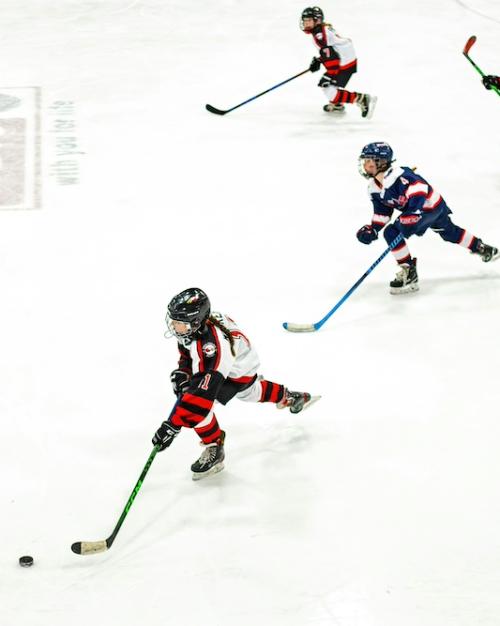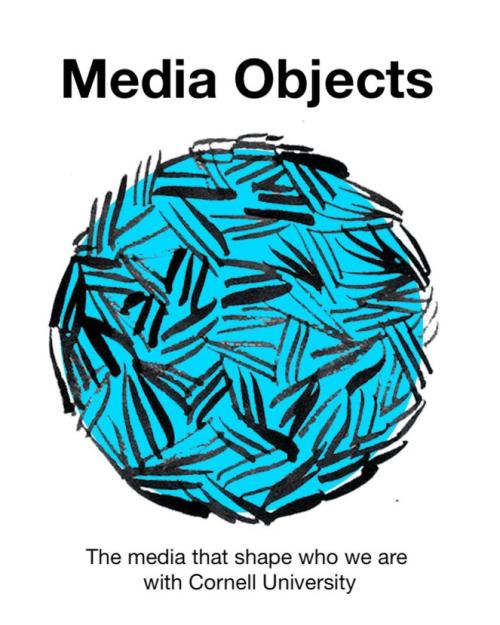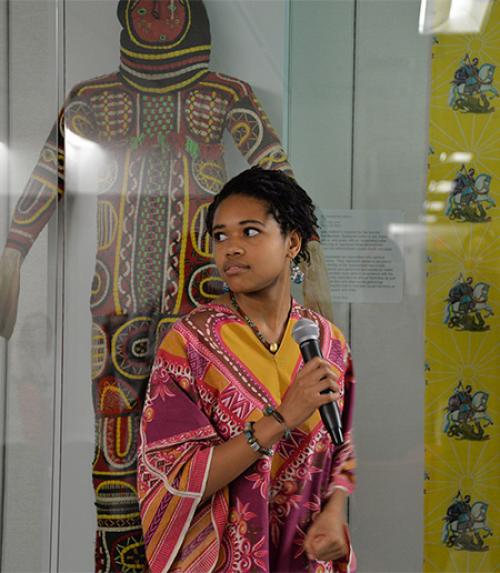Students used Cornell’s photography and textile collections in creative ways as they developed research, critical thinking and writing skills in a pair of fall first-year writing seminars. Their course work culminated in the students curating two exhibitions on campus.
In associate professor of history Judith Byfield’s seminar “Dress, Cloth and Identity in Africa and the Diaspora,” students studied diverse African dress traditions and cultures to explore the continent’s social, economic and political history.
Drawing from their research and the garments available in the Cornell Costume and Textile Collection, the students curated “A-dress-in(g) Africa,” on display through March 25 on the Terrace Level of the Human Ecology Building. The exhibit was co-organized by Denise Green, assistant professor of fiber science and apparel design and director of the collection.
“Through textiles, we can explore many dimensions of a society and also of historical change and process,” Byfield said. “What I had the students do is select an item from the collection and use it as a jumping-off point to explore a range of topics and engage some ideas they could integrate into their future majors.”
In addition to showing how fashion and textiles mark status and identity, the display addresses the effects of historical colonialism and modern globalization. The exhibition includes adire cloth, Nigerian independence garments and bogolafini (mudcloth) from Mali; as well as Ndembu masks and costumes from Zambia on loan from Cornell’s Anthropology Collections.
“We pulled from different parts of the continent … to help them understand that [Africa] is so diverse,” Byfield said. “That diversity matters because it leads to very different historical outcomes and trajectories for different communities.”
The course grew out of Byfield’s research, including her book “The Bluest Hands: A Social and Economic History of Women Indigo Dyers in Western Nigeria.”
The students, she said, “took away an appreciation of Africa, both historically and in the contemporary moment, and of the range of questions that we can explore through material culture – in this instance, cloth and clothing.”
In the seminar “Intersubjective Bodies of Photography,” students investigated the complex relationships between photographer, subject and viewer in 20th-century photography. They began the semester by scouring through thousands of images in Cornell’s Luna Insight image database and in the Herbert F. Johnson Museum of Art photography collections.
The 17 students each chose one photograph to study and include in an exhibition at the end of the course. They made several museum visits, conducted archival research, met with museum staff photographer David Brown and curator Andrea Inselmann, and read assigned texts by Roland Barthes, Susan Sontag and others.
They also kept a course blog and met to discuss the images to “form a concept for an exhibition,” said Alana Ryder, the museum’s Andrew W. Mellon Curatorial Coordinator for Academic Programs, who led the seminar with Edward Curran, instructor in the Department of Romance Studies.
“They spent so much time investigating their adopted photographs that they gained a docent-level knowledge of the photograph and the photographer’s work,” Curran said.
The seminar “engaged us to discuss concepts such as appropriation, voyeurism and exhibition,” said architecture student Melody Li ’20, who chose an image by Robert Frank.
The class grouped the images by topical subpanels: Exhibition: A Subject’s Performance (for the photographer and/or the viewer); Photographic Relationships; Transforming Public Space; and The Outside View (the photographer’s influence on the elements and people in an image).
“There’s an interesting dialogue between each subpanel and the whole exhibit,” Li said.
The temporary exhibit in the museum’s Kress Study Gallery during the last two weeks of classes included work by Frank, Nan Goldin, William Klein, Sally Mann and Andy Warhol.
Students wrote labels for the photographs detailing their interpretations and research findings, drafted and revised the text for the subpanels and gave 10-minute presentations on their selected images, said Curran, whose teaching was supported by the John S. Knight Institute for Writing in the Disciplines’ Buttrick-Crippen Fellowship.
“About 75 percent of our class visits to the museum draw on our photography collection,” Ryder said. “The students were able to make some remarkable observations about the collection. They had an opportunity to focus on one artist or one image, and their work is going to be added to the museum archives.”




